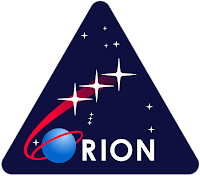
NASA - Space Launch System (SLS) logo / NASA - Orion Exploration Crew Vehicle patch.
July 28, 2016
A crucial part of preparing NASA’s next Orion spacecraft for flight now is underway. Technicians recently began the process of bonding thermal protection system (TPS) tiles to panels that will be installed on Orion.
The tiles will protect the spacecraft from the searing heat of re-entry when it returns from deep space missions.
The first integrated mission of NASA’s Space Launch System (SLS) rocket with Orion, Exploration Mission 1, or EM-1, will lift off from Launch Complex 39B at NASA's Kennedy Space Center in Florida. On the mission, the spacecraft will venture 40,000 miles beyond the orbit of the moon, farther than any spacecraft built for humans has ever traveled, testing the systems needed for the agency’s journey to Mars. The mission will conclude with Orion re-entering through the Earth's atmosphere at 25,000 mph, generating heat at about 5,000 degrees Fahrenheit.
Image above: In the Neil Armstrong Operations and Checkout Building at NASA’s Kennedy Space Center, technicians have begun bonding thermal protection system tiles to the nine panels the will cover the Orion crew module for the agency’s first unpiloted flight test with the Space Launch System (SLS) on the agency’s Journey to Mars. Image Credits: NASA/Cory Huston.
According to Joy Huff, a thermal protection system engineer in the Materials Science Branch of Kennedy Engineering, Orion’s back shell panels and forward bay cover, which helps protect the spacecraft during re-entry, will be protected by silica tiles similar to those used for more than 30 years on the space shuttle.
“The seven to eight technicians and two quality inspectors with Arctic Slope Research Corp. doing the work are veterans of bonding tiles to the shuttle orbiters." she said. "The tiles are manufactured here in Kennedy’s Thermal Protection System Facility.”
Denver-based Lockheed Martin Space Systems Co. is the prime contractor for the Orion spacecraft.
The company provides digital, computer-aided design information that defines the size and shape of each tile. At Kennedy’s TPSF, that information is used to manufacture the tiles. A 3-D camera then scans the as-built shape for comparison to the design information. This ensures that the manufactured tile meets the design requirements before it is placed on one of nine tile panels or the forward bay cover.
The bonding process began in July and will take several months. The work is taking place in the high bay of the Neil Armstrong Operations and Checkout Building where assembly of the Orion crew module’s pressure vessel, or underlying structure, has been taking place since it arrived at the Florida spaceport in February.
Image above: Technicians prepare to bond thermal protection system tiles on the Orion crew module for the agency’s Exploration Mission-1 with the Space Launch System (SLS) rocket. Orion requires about 1,300 tiles. Many of the Orion tiles are standard, except for those which fit around windows, thrusters or antennae. Along with the spacecraft’s heatshield, the tiles will protect Orion from the 5,000 degree Fahrenheit heat of re-entry. Image Credits: NASA/Cory Huston.
Orion will need about 1,300 tiles to protect it. On average, the tiles are 8-inches by 8-inches and many are standard in size allowing them to have the same dimensions with the same part number.
“Some tiles on Orion are a unique design to fit around windows, thrusters and antennas,” Huff said.
Huff noted that Orion tiles incorporate a stronger coating called “toughened uni-piece fibrous insulation,” or TUFI coating, which was used toward the end of the Space Shuttle Program.
“The ‘tougher’ tiles are important to Orion as they will help limit damage during ground processing and by debris in orbit,” Huff said.
Once the tile bonding is complete, the nine panels and forward bay cover will be installed on the crew module after it is mated to its service module.
“For EM-1, the back shell panels will have a different look than Orion’s first test flight,” said Huff.
Orion’s inaugural mission, known as Exploration Flight Test-1, or EFT-1, was flown on Dec. 5, 2014. On that flight, the tiles gave the crew module a black look.
Image above: During Exploration Mission-1, NASA’s Orion spacecraft will venture 40,000 miles beyond the orbit of the moon, farther than any spacecraft built for humans has ever traveled. Image Credit: NASA.
“For EM-1, we will place an aluminized coating over the tiles, giving it a shiny silver look,” she said.
Following deep-space missions, Orion will make a comet-like re-entry through Earth's atmosphere, protected by the tiles and the largest and most advanced heat shield ever constructed. The spacecraft then will splashdown in the ocean.
“The fact that Orion lands in the ocean, requires we replace the tiles after each mission,” Huff said. “The tiles are waterproofed to protect them from fresh water, such as rain. But during re-entry the waterproofing material burns out of the tiles so they do absorb salt water while in the ocean and that adds contaminants that would make their reuse impossible.”
Installing TPS tiles will be a part of preparation for each mission. The work taking place now will help perfect the process.
For EM-1, Orion will travel well beyond the moon for about three weeks, collecting data and allowing mission controllers to assess the performance of the spacecraft.
“We’re looking forward to EM-1,” Huff said. “SLS is the largest rocket ever built. It will help confirm we’re doing things the right way on Orion, and we’ll be another step closer to Mars.”
Related articles:
Engineers Prepare for Orion Water-Impact Testing with Precision to Protect Future Astronauts
http://orbiterchspacenews.blogspot.ch/2015/12/engineers-prepare-for-orion-water.html
NASA Completes Critical Design Review for Space Launch System
http://orbiterchspacenews.blogspot.ch/2015/10/nasa-completes-critical-design-review.html
LIFTOFF! Orion Begins New Era in Space Exploration!
http://orbiterchspacenews.blogspot.ch/2014/12/liftoff-orion-begins-new-era-in-space.html
Related links:
Journey to Mars: https://www.nasa.gov/topics/journeytomars/index.html
Orion Spacecraft: https://www.nasa.gov/exploration/systems/orion/index.html
Images (mentioned), Text, Credits: NASA's Kennedy Space Center, by Bob Granath.
Greetings, Orbiter.ch




